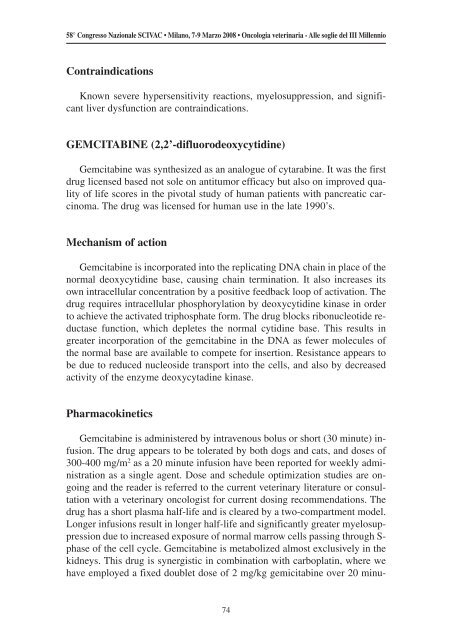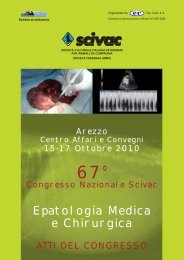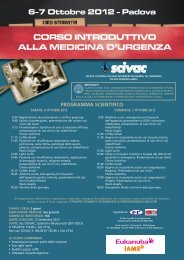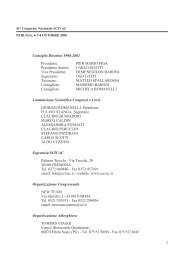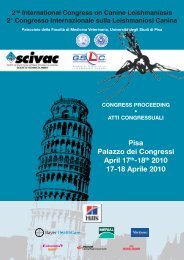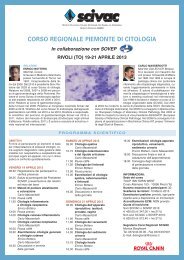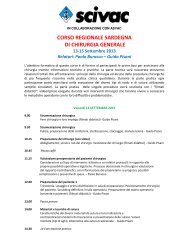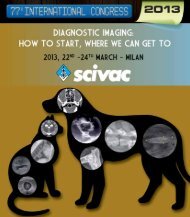58° Congresso Nazionale SCIVAC: Oncologia veterinaria
58° Congresso Nazionale SCIVAC: Oncologia veterinaria
58° Congresso Nazionale SCIVAC: Oncologia veterinaria
Create successful ePaper yourself
Turn your PDF publications into a flip-book with our unique Google optimized e-Paper software.
58° <strong>Congresso</strong> <strong>Nazionale</strong> <strong>SCIVAC</strong> • Milano, 7-9 Marzo 2008 • <strong>Oncologia</strong> <strong>veterinaria</strong> - Alle soglie del III Millennio<br />
Contraindications<br />
Known severe hypersensitivity reactions, myelosuppression, and significant<br />
liver dysfunction are contraindications.<br />
GEMCITABINE (2,2’-difluorodeoxycytidine)<br />
Gemcitabine was synthesized as an analogue of cytarabine. It was the first<br />
drug licensed based not sole on antitumor efficacy but also on improved quality<br />
of life scores in the pivotal study of human patients with pancreatic carcinoma.<br />
The drug was licensed for human use in the late 1990’s.<br />
Mechanism of action<br />
Gemcitabine is incorporated into the replicating DNA chain in place of the<br />
normal deoxycytidine base, causing chain termination. It also increases its<br />
own intracellular concentration by a positive feedback loop of activation. The<br />
drug requires intracellular phosphorylation by deoxycytidine kinase in order<br />
to achieve the activated triphosphate form. The drug blocks ribonucleotide reductase<br />
function, which depletes the normal cytidine base. This results in<br />
greater incorporation of the gemcitabine in the DNA as fewer molecules of<br />
the normal base are available to compete for insertion. Resistance appears to<br />
be due to reduced nucleoside transport into the cells, and also by decreased<br />
activity of the enzyme deoxycytadine kinase.<br />
Pharmacokinetics<br />
Gemcitabine is administered by intravenous bolus or short (30 minute) infusion.<br />
The drug appears to be tolerated by both dogs and cats, and doses of<br />
300-400 mg/m 2 as a 20 minute infusion have been reported for weekly administration<br />
as a single agent. Dose and schedule optimization studies are ongoing<br />
and the reader is referred to the current veterinary literature or consultation<br />
with a veterinary oncologist for current dosing recommendations. The<br />
drug has a short plasma half-life and is cleared by a two-compartment model.<br />
Longer infusions result in longer half-life and significantly greater myelosuppression<br />
due to increased exposure of normal marrow cells passing through S-<br />
phase of the cell cycle. Gemcitabine is metabolized almost exclusively in the<br />
kidneys. This drug is synergistic in combination with carboplatin, where we<br />
have employed a fixed doublet dose of 2 mg/kg gemicitabine over 20 minu-<br />
74


